Force Sensors Market Size
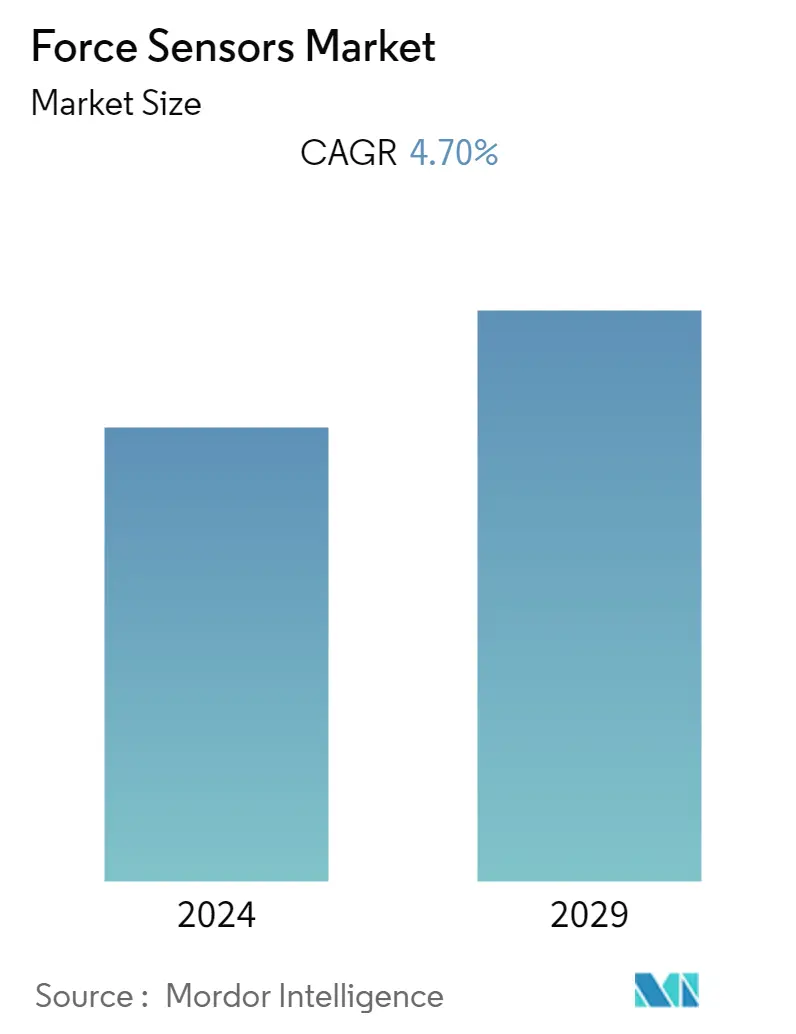
| Study Period | 2019 - 2029 |
| Base Year For Estimation | 2023 |
| CAGR | 4.70 % |
| Fastest Growing Market | Asia-Pacific |
| Largest Market | North America |
| Market Concentration | Medium |
Major Players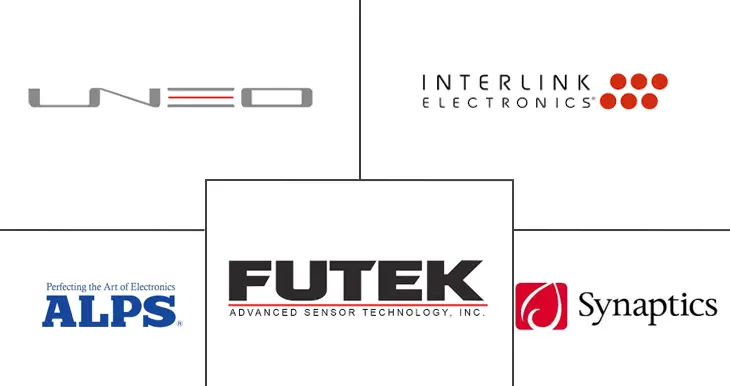
*Disclaimer: Major Players sorted in no particular order |
Need a report that reflects how COVID-19 has impacted this market and its growth?
Force Sensors Market Analysis
The force sensors market is expected to register a CAGR of 4.7% over the forecast period. Force sensors have become critical features in industrial robots by enabling them to be task agnostic and safely operate alongside humans. These sensors have improved the monitoring and management of networked embedded systems. The adoption of automation has transformed the global landscape, as these sensors have become critical to all automated equipment, offering accuracy and precision in all operations.
- Force sensing makes surfaces more intuitive, and the displays enable user experience designers to simplify and improve the control surface layouts on many appliances. It has allowed designers to seamlessly integrate force sensors into new designs by exploring a new generation of appliance user interfaces.
- Force sensors are frequently installed to track the force experienced by vehicle parts such as axle beams and dampers to avoid fatigue failure, particularly in heavy automotive vehicles such as construction trucks and mining vehicles, where overloading or unexpected stress levels may result in higher maintenance costs.
- Furthermore, the increasing safety regulations and rapidly rising adoption of advanced driver assistance systems (ADAS), which alert drivers based on several parameters, are expected to drive the demand for force sensors over the forecast period.
- Moreover, industrial robots are more adaptable, intelligent, and autonomous. The development of force sensor technologies is driving the advancement of robots. Force sensors can detect different forces when applied to the robot's wrist or end-of-arm tooling. The market for force sensors is expanding due to cheap production costs, technical advancements, rising industrial robot demand, the creation of force-measuring medical devices, and expansion and innovation in the industrial sector.
- Additionally, the demand from automotive, consumer electronics, and healthcare industries has increased post-pandemic situation as the government released the restriction and increased demand from the consumer for automotive and consumer electronics, which will further be expected to add growth for the force sensor market. After the COVID-19 pandemic, the global force sensor market showed steady growth due to its demand for various applications such as electric vehicles, autonomous vehicles, smartphones, and smart healthcare devices. Such applications will boost the market in the near future.
- The market's current force sensor product portfolio is relatively standardized in product offerings. Although the market has the potential to cater to a plethora of applications, the offerings of the market players are pretty limited. However, the market is witnessing the introduction of customized force sensor products for specific original equipment manufacturing (OEM) needs.
- However, the significant restraint in the market is the fluctuating demands of the end-user industry. Need is not fixed in the end-user sector and is a challenge to production schedules. Rejection rates at manufacturing facilities are due to damage or poor sensitivity, reducing overall production capacity. Additionally, rapidly changing requirements in the automotive, medical, and aerospace sectors drive the need for more accurate measurements.
Force Sensors Market Trends
This section covers the major market trends shaping the Force Sensors Market according to our research experts:
Automotive Sector is Expected to Register a Significant Growth
- The rising automotive sales and increasing production of vehicles globally are expected to create opportunities. According to the OICA (Organisation Internationale des Constructeurs Automobiles), the sales of automobiles in China in 2021 reached the highest at 26.08 million units. In 2021, around 80.14 million motor vehicles, including cars, and commercial vehicles, were produced globally.
- Furthermore, force sensors are commonly employed in the automotive sector to detect centripetal force during maneuvers to increase driver safety. They are also used in engine management systems (MAP/BAP) and oil pressure monitoring. Because of these advantages, the demand for force sensors in the automobile industry may expand in the coming years.
- The automotive industry has many new opportunities for force sensors in the Research and development of infotainment systems. In recent years, the automotive industry has emerged as an excellent source of demand for touchscreen units. Prominent automotive sensor manufacturers like Bosch, Denso, and Infineon Technologies are investing in technologically advanced, safer, and more secure sensor-based products for various automotive applications.
- Moreover, the increasing demand for technologically sophisticated functionalities in the automotive sector, where force sensors are used for driver safety, engine management systems, and oil pressure systems, is expected to increase demand for force sensors in the future years. Furthermore, the growing popularity of robotics and advancements in IIoT will propel the market.
- Additionally, the increasing safety regulations and rapidly rising adoption of advanced driver assistance systems (ADAS), which alert the driver based on several parameters, are expected to drive the demand for force sensors over the forecast period.
- However, the automotive industry has been impacted by the COVID-19 outbreak, as China is one of the major suppliers of raw materials and finished products. The sector faced a reduction in production, disruption in the supply chain, and price fluctuations. The prominent electronic companies' sales were affected but are expected to grow soon.
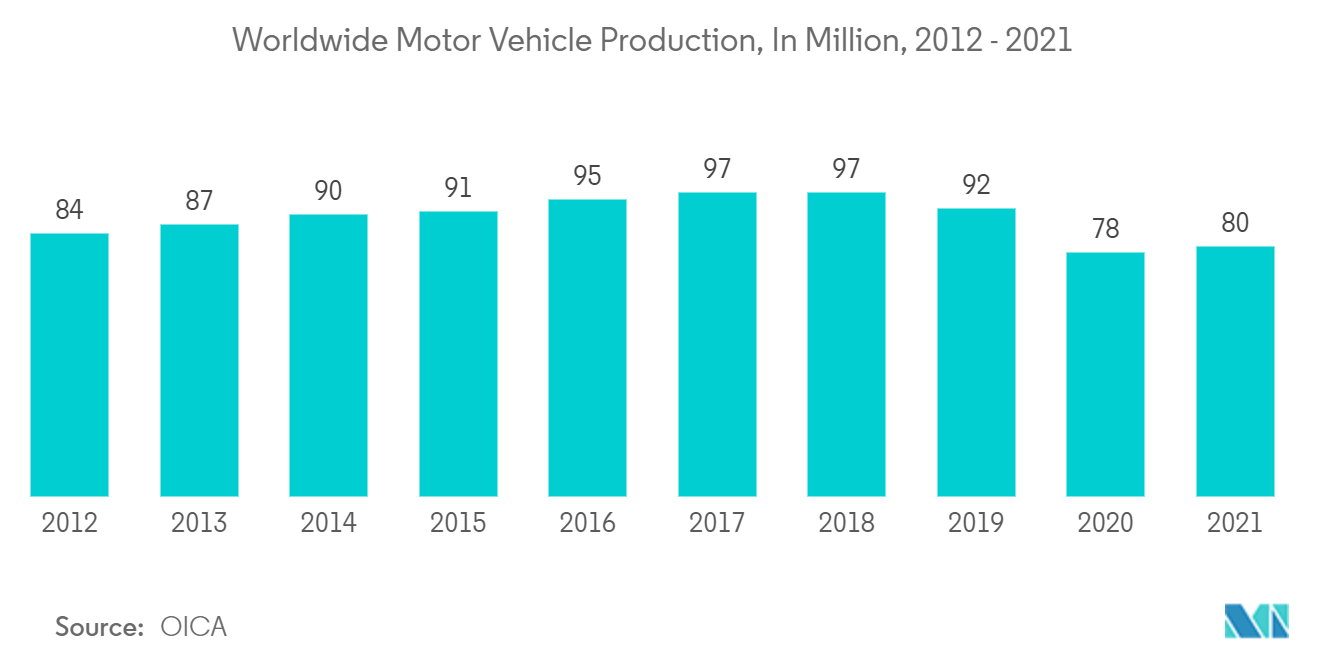
Asia-Pacific to Witness the Significant Growth
- Growing AI and IoT technologies and high demand from the Asian-Pacific region continue to drive the force sensor market growth. Technological advances and rising automotive standards in developing countries such as India, China, and others are impacting the increasing demand for sensors in the manufacturing sector due to multiple benefits, including maximizing operational efficiency, reliability, and effectiveness.
- The region is also one of the most lucrative markets. It is becoming a priority for force sensors due to its prosperous industrial manufacturing industry and high domestic consumption of products that utilize devices with force sensors.
- The automotive industry has also been increasing in India, playing an increasingly important role in the global automotive market. For instance, according to IBEF, the Indian passenger car market was valued at USD 32.7 billion in 2021, and it is expected to reach USD 54.84 billion after five years. Additionally, India's electric vehicle (EV) market is projected to reach INR 50,000 crores (USD 7.09 billion) by 2025. Moreover, according to NITI Aayog and Rocky Mountain Institute (RMI), India's EV financial industry could reach INR 37 lakh (USD 3.7 million) by 2030. India's EV market is predicted to increase at a CAGR of 36% by 2026. These factors will drive the market for force sensors in developing Asian countries.
- Moreover, the Japanese government aims to have all new cars sold in Japan electric or hybrid by 2050. The country plans to offer subsidies to accelerate the private sector development of batteries and motors for electricity-powered cars. Besides, the increasing investments to encourage the deployment of autonomous vehicles are expected to drive the growth prospect for force sensors.
- Such optimistic regional developments are expected to boost market growth during the forecast period. It is expected to drive the market for force sensors likely.
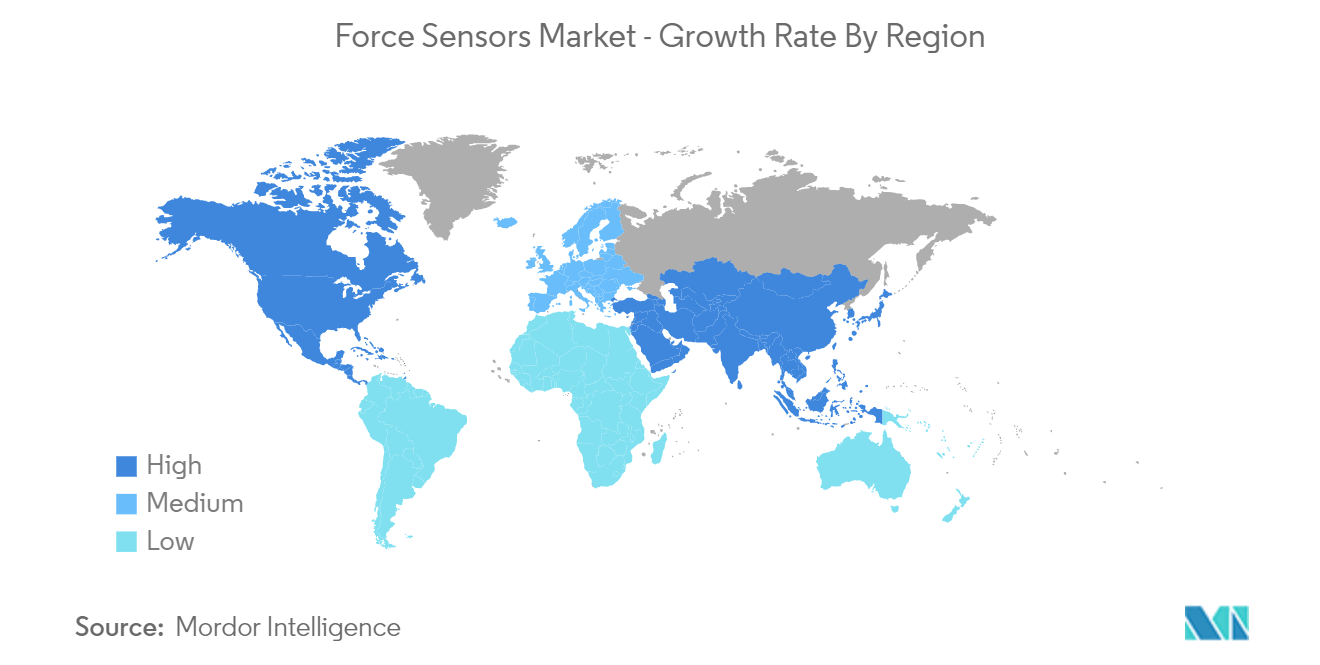
Force Sensors Industry Overview
The force sensors market is moderately fragmented as the market is quite competitive and consists of a few major players, such as Sensata Technologies, Alps Electric Co. Ltd, Synaptics Inc., Interlink Electronics Inc., Pressure Profile Systems Inc., and Uneo Inc.
- October 2022 - Sensata Technologies announced its new Brake Pedal Force Sensor for electromechanical brakes (EMBs), enabling safer and better-performing braking systems. Sensata's micro strain gauge Brake Pedal Force sensor supports the future of braking. Implementing this sensor reduces a vehicle's stopping distance compared to existing technologies. It improves braking by accurately and rapidly capturing a driver's braking intent.
- October 2022 - Forsentek Co. Limited released advanced load cells, force sensors, and various measuring instruments. These are designed with high-quality components to ensure they function at their best. Clients can also get a multi-axis force sensor designed with advanced functionality. These sensors are designed with a high resistance level to ensure they can withstand high impacts and keep working effectively.
Force Sensors Market Leaders
-
Alps Electric Co. Ltd
-
Synaptics Inc.
-
Interlink Electronics Inc.
-
Uneo Inc.
-
Futek Advanced Sensor Technology Inc.
*Disclaimer: Major Players sorted in no particular order
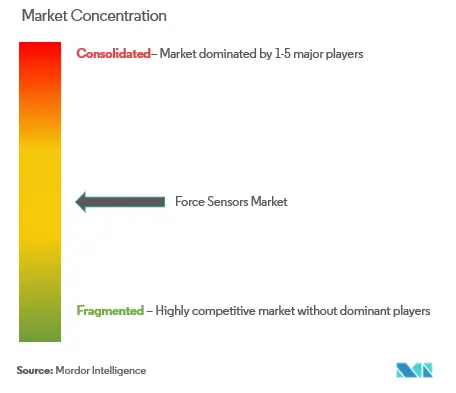
Force Sensors Market News
- March 2022 - Apple filled the latest patents indicating that Apple is trying to roll out Force Touch. According to the brand's most recent patent applications, new force sensors for the iPhone, iPad, MacBook, and Apple Watch are coming. The web publication Patently Apple has revealed the development.
- June 2022 - The University of Cambridge is working on developing brand-new microfluidic force sensors. The new smart sensors are anticipated to extend implant lifetimes and lower the likelihood that patients would require challenging revision surgery. They help balance soft tissue during hip replacement and position an orthopedic implant correctly.
Force Sensors Market Report - Table of Contents
1. INTRODUCTION
- 1.1 Study Assumptions and Market Definitions
- 1.2 Scope of the Study
2. RESEARCH METHODOLOGY
3. EXECUTIVE SUMMARY
4. MARKET DYNAMICS
- 4.1 Market Overview
-
4.2 Market Drivers
- 4.2.1 Innovation and Development in the Consumer Electronics Sector
- 4.2.2 Surging Demand in the Automotive Sector
-
4.3 Market Restraints
- 4.3.1 Fluctuating Market Demands and Customization Issues
- 4.4 Value Chain/Supply Chain Analysis
-
4.5 Industry Attractiveness - Porter's Five Forces Analysis
- 4.5.1 Threat of New Entrants
- 4.5.2 Bargaining Power of Buyers
- 4.5.3 Bargaining Power of Suppliers
- 4.5.4 Threat of Substitute Products
- 4.5.5 Intensity of Competitive Rivalry
- 4.6 Assessment of COVID-19 Impact on the Industry
5. MARKET SEGMENTATION
-
5.1 Type
- 5.1.1 Tension Force Sensors
- 5.1.2 Compression Force Sensors
- 5.1.3 Tension and Compression Force Sensors
-
5.2 End-user Industry
- 5.2.1 Healthcare
- 5.2.2 Industrial Manufacturing
- 5.2.3 Automotive
- 5.2.4 Aerospace and Defense
- 5.2.5 Consumer Electronics
- 5.2.6 Other End-user Industries
-
5.3 Geography
- 5.3.1 North America
- 5.3.2 Europe
- 5.3.3 Asia-Pacific
- 5.3.4 Latin America
- 5.3.5 Middle East and Africa
6. COMPETITIVE LANDSCAPE
-
6.1 Company Profiles
- 6.1.1 Alps Electric Co. Ltd
- 6.1.2 Synaptics Inc.
- 6.1.3 Interlink Electronics Inc.
- 6.1.4 Pressure Profile Systems Inc.
- 6.1.5 Uneo Inc.
- 6.1.6 Futek Advanced Sensor Technology Inc.
- 6.1.7 Tekscan Inc.
- 6.1.8 Hottinger Baldwin Messtechnik (HBM) GmbH
- 6.1.9 Kavlico Corporation
- 6.1.10 Flintec Group AB
- 6.1.11 Tecsis GmbH
- 6.1.12 Shenzhen New Degree Technology Co. Ltd
- 6.1.13 Sensel Inc.
- 6.1.14 Tangio Printed Electronics
- 6.1.15 NextInput Inc.
- *List Not Exhaustive
7. INVESTMENT ANALYSIS
8. MARKET OPPORTUNITIES AND FUTURE TRENDS
** Subject To AvailablityForce Sensors Industry Segmentation
Force sensors are devices that transform external force into digital signals, allowing the parent system to detect, measure, and monitor the quantity and direction of applied force. They have become essential elements in industrial robots, allowing them to be job agnostic and work safely alongside humans. These sensors have improved networked embedded system monitoring and administration.
The force sensors market is segmented by type (tension force sensors, compression force sensors, and tension and compression force sensors), End-user industry (healthcare, industrial manufacturing, automotive, aerospace and defense, consumer electronics, and other end-user industries), and geography. The market sizes and forecasts are provided in terms of value (USD million) for all the above segments.
| Type | Tension Force Sensors |
| Compression Force Sensors | |
| Tension and Compression Force Sensors | |
| End-user Industry | Healthcare |
| Industrial Manufacturing | |
| Automotive | |
| Aerospace and Defense | |
| Consumer Electronics | |
| Other End-user Industries | |
| Geography | North America |
| Europe | |
| Asia-Pacific | |
| Latin America | |
| Middle East and Africa |
Force Sensors Market Research FAQs
What is the current Force Sensors Market size?
The Force Sensors Market is projected to register a CAGR of 4.70% during the forecast period (2024-2029)
Who are the key players in Force Sensors Market?
Alps Electric Co. Ltd, Synaptics Inc., Interlink Electronics Inc., Uneo Inc. and Futek Advanced Sensor Technology Inc. are the major companies operating in the Force Sensors Market.
Which is the fastest growing region in Force Sensors Market?
Asia-Pacific is estimated to grow at the highest CAGR over the forecast period (2024-2029).
Which region has the biggest share in Force Sensors Market?
In 2024, the North America accounts for the largest market share in Force Sensors Market.
What years does this Force Sensors Market cover?
The report covers the Force Sensors Market historical market size for years: 2019, 2020, 2021, 2022 and 2023. The report also forecasts the Force Sensors Market size for years: 2024, 2025, 2026, 2027, 2028 and 2029.
Force Sensors Industry Report
Statistics for the 2024 Force Sensors market share, size and revenue growth rate, created by Mordor Intelligence™ Industry Reports. Force Sensors analysis includes a market forecast outlook to 2029 and historical overview. Get a sample of this industry analysis as a free report PDF download.

